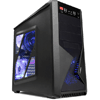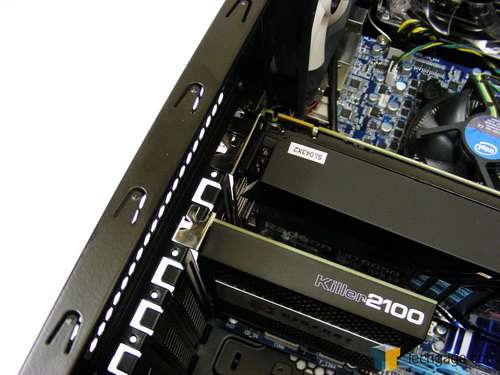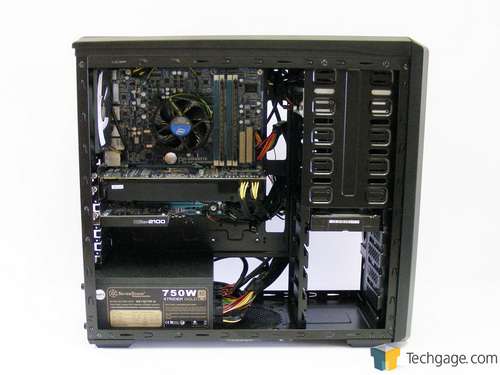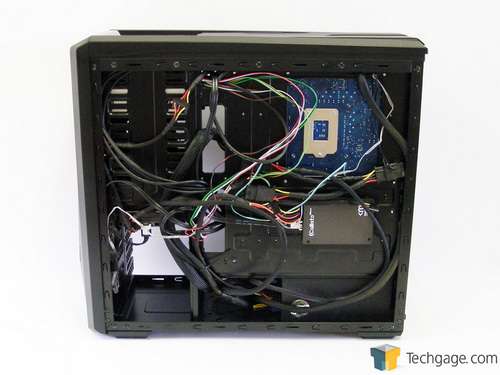- Qualcomm Launches Snapdragon 4 Gen 2 Mobile Platform
- AMD Launches Ryzen PRO 7000 Series Mobile & Desktop Platform
- Intel Launches Sleek Single-Slot Arc Pro A60 Workstation Graphics Card
- NVIDIA Announces Latest Ada Lovelace Additions: GeForce RTX 4060 Ti & RTX 4060
- Maxon Redshift With AMD Radeon GPU Rendering Support Now Available
Zalman Z9 Plus Mid-Tower Chassis Review

It’s been a good two-and-a-half years since we’ve taken a look at a Zalman chassis, so with the announcement of the ~$69 Z9 Plus, we were eager to get one in and see how it compared to the current fleet of sub-$100 offerings on the market. With that, let’s see what the Z9 Plus gives us aside from its good looks and focus on efficient airflow.
Page 3 – Installation & Testing
This being my first experience with a Zalman case, I wasn’t sure what to expect. I have used its CPU coolers in the past and reviewed an external hard drive enclosure, but have heard good things about its cases. Along the way, though, I ran into two problems that will make or break this case.
The first was that the frame didn’t seem quite square. When installing the motherboard I was able to line it up with the standoffs but it didn’t quite line up to the rear I/O shield. It wasn’t off by much but it’s enough to cause some concern. As I worked my way down the case and installed the GPU and NIC card I found that they did not line up properly either.
In order to secure the GPU in place I had to push it towards the PCI slot opening and hold it there while I secured it in place. The same had to be done with the NIC card but to a greater extent since it was further down the case in the bottom PCI-E slot. Both components did install but there is a fair bit of force being placed on the first PCI-E slot since it locks the GPU in place and the NIC card almost feels like it’s close to not making proper contact.
The second issue was when installing a solid-state drive behind the motherboard tray, the four tabs where the screws are threaded through were too tight. I was able to bend them out by hand to allow the drive to fit. The fact that I could bend them by hand coupled with the issue with the expansion cards makes me think that this case may be prone to warping. The shipping box was in near perfect condition and the Styrofoam end caps used to keep it safe during transit were in tact as well.
Aside from that, everything went in lickity-split. All of the front panel cables were long enough to reach the connections on the motherboard, even the poorly placed audio header at the very back of the board. Kudos to the Zalman design team on the hard drive mounting system too. It is one of the most solid tool-less systems I have ever used. Screws are pushed through rubber washers and are secured into the side of the drive. The drive then slides in on the drive bay rails where plastic clips keep them firmly in place.
There is a little over half an inch of room between the motherboard tray and the right side panel. The test system is far from robust but I did end up having a little trouble putting the right side panel back on once all components were installed.
Sadly, the CoolIT Vantage used in my earlier review of the SilverStone FT03 met with an untimely demise, so stock cooling is being used to test temperatures. Due to the fact that the stock Intel heatsink is grossly underpowered, even running LinX through the use of OCCT to test full load temperatures proved to be too dangerous as they went into the 90s. Due to this, only stock idle CPU temperatures are available.
I was able to test the temperatures on the GPU however. A 20 minute run of OCCT’s built in GPU test was performed at stock clocks and again while overclocked. The final clocks were 1020MHz on the core and 1200MHz for the memory with a +0.025V increase using Sapphire Technology’s TriXX overclocking utility. Stability testing was done prior to ensure the GPU test completes the full run with AIDA64 Extreme Engineer monitoring and recording all temperatures.
The components used in the build are:
|
Component
|
Techgage Hard Drive Test System
|
| Processor |
Intel Core i3-530 – Dual-Core (2.93GHz)
|
| Motherboard |
GIGABYTE GA-H55M-USB3 – H55-based
|
| Memory |
G.Skill ECO 2x2GB DDR3-1600
|
| Graphics |
Sapphire Radeon HD 6850 Toxic
|
| Audio |
On-Board Audio
|
| Storage |
Mushkin Callisto Deluxe 60GB SSD
Western Digital Caviar Black 640GB |
| Power Supply |
SilverStone Strider Gold 750W
|
| Cooling |
Stock
|
| Et cetera |
Bigfoot Killer NIC
Windows 7 Ultimate 64-bit |
Even with the hardware breakdown limiting what tests could be run I am happy to say that CPU temperatures stayed at 33°C while idle. This is on par with the Lian Li PC-50WB that these components were pulled from. For GPU temperatures, stock idle and stock load temperatures were 44°C and 86°C respectively. When overclocked, GPU temperatures reached 45°C at idle and 91°C under full load. Again, this is dead on with the Lian Li.
Our case testing system is still in the works but once those components are finalized, a database of stock and overclocked CPU and GPU temperatures will be built for comparison purposes to ensure future cases deliver on cooling, so stay tuned for that.
Support our efforts! With ad revenue at an all-time low for written websites, we're relying more than ever on reader support to help us continue putting so much effort into this type of content. You can support us by becoming a Patron, or by using our Amazon shopping affiliate links listed through our articles. Thanks for your support!







